1936, the first German medium tank
Planned since the beginning of the thirties, with the rejection of the Versailles treaty, the Panzer III was a medium tank project, destined to comprise the bulk of the German armored forces. However, by 1933, German industry was still unable to produce such a tank, and the Panzer I and II were intended to improve industrial skills and methods, as well as to train crews for the future medium tanks to come. The Panzer III’s godfather was Heinz Guderian, a prolific armored warfare writer and theoretician, who envisioned an ideal design for the task of both dealing with other tanks and providing infantry support.
His plans were submitted to the the Inspector for Mechanized Troops in 1934, under the name of Versuchkraftfahrzeug 619. However, it as not approved by the Waffenamt (ordnance department), because of the choice of a 50 mm (1.97 in) gun. The ordnance department was indeed satisfied with the 37 mm (1.46 in) Pak 36, of which large numbers were already in stock. It was already the main infantry support gun, allowing easy ammunition management and standardization. This short-sighted view proved a major blunder. Numerous pre-series versions appeared, in the quest of a suitable suspension. The Panzer Ausf.A to C proved underarmed and underarmored. After Guderian met Hitler in 1939 about his concerns, the 50 mm (1.97 in) upgrade was again put on the table before the Waffenamt, now supported by the Führer. Nevertheless, the Waffenamt simply ignored the orders and delayed the upgrade until the Ausf.J appeared in 1941.
Four companies (Daimler-Benz, Krupp, MAN, and Rheinmetall) were chosen to produce a prototype each, which were ready by 1936. The Daimler-Benz model was finally chosen after intensive trials, and the production of the first series took place in 1937.
The Daimler-Benz prototype incorporated a three seat turret, with an intercom system. Both proved very innovative features, the latter being well ahead of its time. Radio was also part of the equipment from the start, and the commander was directly informed by the platoon commander, also easing coordination with other Panzers. At the same time, most of the armored forces in the world used maneuver signal flags, the sole radio-equipped vehicles being the commander tanks. This feature alone was perfectly suited for Blitzkrieg style combined-arms tactics, and allowed tactical superiority. Later on, Allied tank designs also adopted the three-man turret configuration.
The test-series: Ausf.A to D
The easiest way to tell the difference between a Panzerkampfwagen Mark III and a Mark IV is to count the road wheels. The Mk III has six pairs of road wheels each side and the longer Mk IV has eight. Unfortunatly this simple guide does not take into account the early experimental trial versions that were used to test different track and suspension systems among other features. The Panzer III was the main battle tank of the German army during the early years of the Second World War. It would later be replaced by the Panzer IV, Panther and Tiger tank.
On 27 January 1934 authorisation was given to develop a 10 ton tank with a 3.7 cm cannon L/45 in the turret, code-named Zugfuehrerwagen (platoon leader’s tank) abbreviated to Z.W. Two trial tank chassis were ordered from Daimler-Benz and one from M.A.N. Two trial turrets were commissioned from Krupp and one from Rheinmetall. These orders were increased.
Each side of the Panzer III Ausf.A (Z.W.1) had five large road wheels with coil spring suspension and two track return rollers. Each side of the Panzer III Ausf.B (Z.W.3) had eight smaller road wheels with leaf spring suspension in two groups and three track return rollers. Each side of the Panzer III Ausf.C and D (Z.W.4) had eight road wheels with leaf spring suspension in three groups and three track return rollers. The configuration of the leaf spring suspension was different of the Ausf.C and Ausf.D. They were all powered by a Maybach HL 108 TR 250 hp engine but had different transmission gearboxes.
The armour on the front, sides and rear of the tank chassis was 14.5 mm thick. The turret sides and rear were also 14.5 mm thick. The gun mantle and front were 16 mm thick. They saw combat during the invasion of Poland and Norway. As newer, more heavily armoured versions of the Panzer III arrived in Panzer Regiments as replacements the surviving tanks were sent to tank crew training schools.
Panzer III Ausf.A specifications | |
| Dimensions | 5.80 m x 2.81 m x 2.36 m (19ft x 9ft 3in x 7ft 10in) |
| Armament | 1 × 3.7 cm KwK 36 L/46.5 |
| Machine Guns | 3 × 7.92 mm MG34 |
| Armor | 5 mm – 16 mm |
| Weight | 15 tons |
| Crew | 5 |
| Propulsion | Maybach HL 108 TR V-12 250hp gasoline/petrol engine |
| Max Speed | 35 km/h (21.7 mph) |
| Range | 165 km (102 miles) |
| Total built | 10 |
Panzer III Ausf.B specifications | |
| Dimensions | 5.66 m x 2.81 m x 2.38 m (18ft 7in x 9ft 3in x 7ft 10in) |
| Armament | 1 × 3.7 cm KwK 36 L/46.5 |
| Machine Guns | 3 × 7.92 mm MG34 |
| Armor | 5 mm – 16 mm |
| Weight | 16 tons |
| Crew | 5 |
| Propulsion | Maybach HL 108 TR V-12 250hp gasoline/petrol engine |
| Max Speed | 35 km/h (21.7 mph) |
| Range | 165 km (102 miles) |
| Total built | 15 |
Panzer III Ausf.C specifications | |
| Dimensions | 5.85 m x 2.82 m x 2.41 m (19ft 2in x 9ft 3in x 7ft 11in) |
| Armament | 1 × 3.7 cm KwK 36 L/46.5 |
| Machine Guns | 3 × 7.92 mm MG34 |
| Armor | 5 mm – 16 mm |
| Weight | 16 tons |
| Crew | 5 |
| Propulsion | Maybach HL 108 TR V-12 250hp gasoline/petrol engine |
| Max Speed | 35 km/h (21.7 mph) |
| Range | 165 km (102 miles) |
| Total built | 15 |
Panzer III Ausf.D specifications | |
| Dimensions | 5.92 m x 2.82 m x 2.41 m (19ft 5in x 9ft 3in x 7ft 11in) |
| Armament | 1 × 3.7 cm KwK 36 L/46.5 |
| Machine Guns | 3 × 7.92 mm MG34 |
| Armor | 5 mm – 16 mm |
| Weight | 16 tons |
| Crew | 5 |
| Propulsion | Maybach HL 108 TR V-12 250hp gasoline/petrol engine |
| Max Speed | 35 km/h (21.7 mph) |
| Range | 165 km (102 miles) |
| Total built | 30 |
Panzer III Ausf.E
The Ausf.E was the first version of the mass produced Panzer III tanks and was very similar to the Ausf.F and Ausf.G which differed in minor specifications. The previous versions had been used to test different suspension systems and other features. The Panzer III Ausf.E was fitted with torsion bar suspension with six roadwheels on individual swing axles. Three track return rollers were positioned above the road wheels.
The slightly more powerful 265 hp Maybach HL 120 TR engine was used in the Panzer III Ausf.E from earlier versions. The Ausf.F and Ausf.G were fitted with the 285 hp HL 120 TRM version which had a different magneto and modified cooling system.
The armor on this batch of Panzer III tanks was thickened to 30 mm on the turret front, rear and sides. The armor on the front and sides of the hull were also 30 mm thick. The angled front glacis and lower hull plates were 25 mm thick. The hull rear was 20 mm thick.
The 3.7 cm KampfwagonKanone (Kw.K – tank gun) has a length of 1716 mm (L/46.5) from the muzzle to the back of the breech. It had a rate of fire of up to 20 rounds per minute. This was achieved by having a semi-automatic breech which opens shortly before the end of the recoil and the spent casing ejected. The breech must be opened by hand prior to the first shot, but it closes by itself when a round is loaded. Its PzGr.18 AP shells could penetrate 34 mm thick armour laid at a 30 degree angle at a range of 100 m, 29 mm at 500 m and 22 mm at 1km. This was adequate to deal with the threats it faced in 1939.
A few Panzer III Ausf.E saw combat in Poland in 1939. They were used in the invasion of Holland, Belgium and France in May 1940. These tanks were upgraded during their combat life with different guns (5 cm Kw.K 38 L/42) turrets and more armour. They were used on the Eastern Front and in North Africa.
Panzer III Ausf.E specifications | |
| Dimensions | 5.38 m x 2.91 m x 2.50 m (17ft 8in x 9ft 6in x 8ft 2in) |
| Armament | 3.7 cm KwK 36 L/46.5 or 5 cm KwK 38 L/42 |
| Machine Guns | 3 × 7.92 mm MG34 (The 5 cm gun turret only had one coaxial machine gun not two) |
| Armor | 10 mm – 30 mm (additional 30mm plate added later) |
| Weight | 19.5 tons |
| Crew | 5 |
| Propulsion | Maybach HL 120 TR V-12 265hp gasoline/petrol engine |
| Max Speed | 40 km/h (24.85 mph) |
| Range | 165 km (102 miles) |
| Total built | 96 |
Panzer III Ausf.F
The Panzer III Ausf.F tank was very similar to the Ausf.E and Ausf.G. The previous versions had been used to test different suspension systems and other features. The Panzer III Ausf.E was fitted with torsion bar suspension with six roadwheels on individual swing axles. Three track return rollers were positioned above the road wheels.
A turret ring deflector guard was added to the front of the hull superstructure. The dummy periscope designed to draw sniper fire was removed from in front of the commanders cupola on later built turrets. Some early ones still had it. A smoke grenade launcher was added to the rear of the tank chassis. Two armoured brake vents were fitted to the front upper glacis plate.
It was fitted with the 285 hp HL 120 TRM petrol/gasoline engine which had a different magneto and modified cooling system than the HL 120 TR 250 hp engine fitted on the Ausf.E.
The armor on the Ausf.E to G was thickened to 30 mm on the turret front, rear and sides. The armor on the front and sides of the hull were also 30 mm thick. The angled front glacis and lower hull plates were 25 mm thick. The hull rear was 20 mm thick.
The 3.7 cm KampfwagonKanone (Kw.K – tank gun) has a length of 1716 mm (L/46.5) from the muzzle to the back of the breech. It had a rate of fire of up to 20 rounds per minute. This was achieved by having a semi-automatic breech which opens shortly before the end of the recoil and the spent casing ejected.
The factory painted dark grey (dunkelgrau RAL 46) and dark brown (dunkelbraun RAL 45) camouflage pattern was discontinued by order dated 31 July 1940. They were just painted dunkelgrau after that date. Most were used in the invasion of Holland, Belgium and France in May 1940. These tanks were upgraded during their combat life with different guns, turrets and more armour.
Later Panzer III Ausf.F were fitted with 5 cm Kw.K 38 L/42 guns. An armoured vent was fitted to the roof of the turret and rear engine deck to enable it to cope with the dust and heat of the North African desert. It was paint it in dark yellow (dunkelgelb). They were used on the Eastern Front.
Panzer III Ausf.F specifications | |
| Dimensions | 5.38 m x 2.91 m x 2.50 m (17ft 8in x 9ft 6in x 8ft 2in) |
| Armament | 3.7 cm KwK 36 L/46.5 or 5 cm KwK 38 L/42 |
| Machine Guns | 3 × 7.92 mm MG34 (The 5 cm gun turret only had one coaxial machine gun not two) |
| Weight | 19.5 tons |
| Armor | 10 mm – 30 mm (additional 30mm plate added later) |
| Crew | 5 |
| Propulsion | Maybach HL 120 TRM V-12 285hp gasoline/petrol engine |
| Max Speed | 40 km/h (24.85 mph) |
| Range | 165 km (102 miles) |
| Total built | 636 |
Panzer III Ausf.G
The Panzer III Ausf.G was produced between March 1940 and early 1941. It was very similar to the Ausf.E and Ausf.F with minor differences in specifications. The previous versions had been used to test different suspension systems and other features. The Panzer III Ausf.G was fitted with torsion bar suspension with six roadwheels on individual swing axles. Three track return rollers were positioned above the road wheels.
It was fitted with the 285 hp HL 120 TRM petrol/gasoline engine which had a different magneto and modified cooling system than the HL 120 TR 250 hp engine fitted on the Ausf.E.
The armor on the Panzer III Ausf.E – Ausf.F tanks was thickened to 30 mm on the turret front, rear and sides. The armor on the front and sides of the hull were also 30 mm thick. The angled front glacis and lower hull plates were 25 mm thick. The hull rear was 30 mm thick on the Ausf.G.
A turret ring deflector guard was added to the front of the hull superstructure. The dummy periscope designed to draw sniper fire was removed from in front of the commanders cupola on later built turrets. Some early ones still had it. A smoke grenade launcher was added to the rear of the tank chassis. Two armored brake vents were fitted to the front upper glacis plate. Armored vents were added to the turret roof and to the rear of the engine deck.
The first Ausf.G tanks were armed with 3.7 cm Kw.K L/46.5 tank gun. Some took part in the invasion of Holland, Belgium and France in May 1940. After experiences during the battle of France later versions were armed with the 5 cm Kw.K 38 L/42 gun. They were used on the Eastern Front and in North Africa. These tanks were upgraded during their combat life with different guns, turrets and more armour. Rear turret stowage boxes were sometimes fitted later.
The factory painted dark grey (dunkelgrau RAL 46) and dark brown (dunkelbraun RAL 45) camouflage pattern was discontinued by order dated 31 July 1940. They were just painted dunkelgrau after that date. Those going to North African were painted dark yellow (dunkelgelb).
Weight19.5 tons
Panzer III Ausf.G specifications | |
| Dimensions | 5.38 m x 2.91 m x 2.50 m (17ft 8in x 9ft 6in x 8ft 2in) |
| Armament | 3.7 cm KwK 36 L/46.5 or 5 cm KwK 38 L/42 |
| Machine Guns | 3 × 7.92 mm MG34 (The 5 cm gun turret only had one coaxial machine gun not two) |
| Armor | 10 mm – 30 mm (additional 30mm plate added later) |
| Crew | 5 |
| Propulsion | Maybach HL 120 TRM V-12 285hp gasoline/petrol engine |
| Max Speed | 40 km/h (24.85 mph) |
| Range | 165 km (102 miles) |
| Total built | 950 |
Panzer III Ausf.H
The Panzer III Ausf.H was the first version of the tank to be designed with a turret fitted with the 5 cm Kw.K 38 L/42 tank gun and with 60 mm of frontal armour, rather than having these specifications added later in an upgrade program. They started to be delivered in late 1940 and early 1941.
The 5 cm Kampfwagenkanone L/42 tank gun was semi-automatic: the breech block remained open after firing to enable the next round to be loaded quicker. Its standard armour piercing AP shell could penetrate or 55 mm of armour laid at an angle of 30 degrees at a range of 100 m, 46 mm at 500 m and 36 mm at a range of 1 km. The turret only had one coaxial 7.92 mm MG34 machine gun, another MG34 was mounted in the hull.
The tank was still powered by the Maybach HL 120 TRM 285 hp petrol/gasoline which gave it a top road speed of 42 km/h (26 mph). Two armoured brake vents were fitted to the front of the hull armour.
The 60 mm thick armor on the hull front, upper hull front and rear was constructed by welding two 30 mm armor plates together. The side armour was 30 mm thick and the angled front glacis and lower hull front plate was 25 mm thick. The angled armor on the front rear and sides of the turret was 30 mm thick. The curved gun mantle was 35 mm thick. The turret had an armored ventilation fan. Tanks going to North Africa were fitted with armored vents on the engine deck. Rear turret stowage bins were fitted later.
Because of the increase in weight wider wheels and tracks were introduced. New front drive wheels and rear idler wheels were fitted as well as a different shock absorber. Because of supply problems some of the early Ausf.H tanks were fitted with shock absorbers and wheels used on the Ausf.G.
Panzer III Ausf.H specifications | |
| Dimensions | 5.38 m x 2.95 m x 2.50 m (17ft 8in x 9ft 8in x 8ft 2in) |
| Armament | 5 cm KwK 38 L/42 |
| Machine Guns | 2 × 7.92 mm MG34 |
| Armor | 10 mm – 60mm |
| Weight | 21.5 tons |
| Crew | 5 |
| Propulsion | Maybach HL 120 TR V-12 265hp gasoline/petrol engine |
| Max Speed | 42 km/h (26 mph) |
| Range | 165 km (102 miles) |
| Total built | 500 |
Panzer III Ausf.J
The Panzer III Ausf.J was very similar to the Panzer.III Ausf.G. It was built with a turret fitted with a 5 cm Kw.K 38 L/42 tank gun. It had similar armor thickness and was powered by the same Maybach HL 120 TRM petrol/gasoline 285 hp engine.
The basic armor thickness at the hull front, upper hull front and rear of the tank was now 50 mm. The front glacis was 25 mm thick. 30 mm armour was used on the hull sides, lower hull rear and front. The armor on the front, sides and rear of the turret was 30 mm thick. The rounded gun mantle was 50 mm thick. In the spring of 1941, additional armor plate was added internally to the front of the turret increasing it to a maximum of 57 mm in places.
The chassis was lengthened to create better engine compartment ventilation and tow eyes. The design of the armored front brake vents was changed. The turret was fitted with an armoured extractor fan on the roof.
The 5 cm KampfwagonKanone (Kw.K – tank gun) had a length of 2100 mm (L/42) from the muzzle to the back of the breech. It had a rate of fire of up to 20 rounds per minute. This was achieved by having a semi-automatic breech which opened before the end of the recoil, ejected the spent casing and allowed for the quick loading of the next shell.
From December 1941 the 5 cm Kw.K L/60 tank gun started to be fitted instead of the 5 cm Kw.K L/42 gun, as stocks arrived in factories. Tanks sent to North Africa had armoured vents fitted on the rear engine deck. In April 1941 stowage bins started to be fitted to the rear of the turret.
Using the appearance of spaced armor on Panzer III tanks is not a reliable way of identifying the different Ausf version. Late production Ausf.J tanks had 20 mm spaced armor fitted to the front of the turret and the hull. Some older tanks had it back fitted later.
Panzer III Ausf.J specifications | |
| Dimensions | 5.49 m x 2.95 m x 2.50 m (18ft x 9ft 8in x 8ft 2in) |
| Armament | 5 cm Kw.K 38 L/42 later 5 cm Kw.K L/60 |
| Machine Guns | 2 × 7.92 mm MG34 |
| Armor | 10 mm – 50mm (later 57mm) |
| Weight | 21.6 tons |
| Crew | 5 |
| Propulsion | Maybach HL 120 TR V-12 265hp gasoline/petrol engine |
| Max Speed | 40 km/h (24.85 mph) |
| Range | 155 km (96.31 miles) |
| Total built | about 1521 L/42 (about 1021 L/60) |
Panzer III Ausf.K
The Ausf.K was a command tank (Befehlspanzer) version of the Ausf.J, but different from the former Befehlspanzer versions, as their armament was real. No more dummy guns were used. Production record is unknown.
Late production Panzer III tanks
During the fall of 1942, new projects came to completely renew the German armored forces. These was a new generation of tanks, the first of them being the Tiger, followed closely by the Panther, much closer to the modern idea of a perfect “main battle tank”. Considering this, the 1936 Panzer III was seen as obsolete, at least in its antitank role. However, Daimler Benz still found a way to improve its old battle-hardened tank, They mounted a deep-wading exhaust, for river crossing capabilities on the Ausf.M (250 built until early 1943), and since the beginning, fitted with Schürzen (armored skirts). In mid-1943 came the last version, the Ausf.N, with a short-barrel 75 mm (2.95 in) KwK 37 L/24 gun capable of firing, for the first time, HEAT projectiles. This tank was the perfect dual-purpose, versatile model, which inspired retrofitting of earlier versions. Since new specialized tank-hunters and heavy battle tanks were available, the Panzer III was increasingly confined to an infantry support role.
Panzer III Illustrations
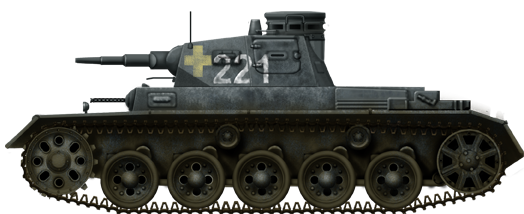
A Panzer III Ausf.A, one of the very first delivered, in 1937. This one was part of the Polish campaign in September. Early versions were converted to command tanks or, as they were outnumbered by lighter models, Zugfuhrerwagen or platoon commanders.
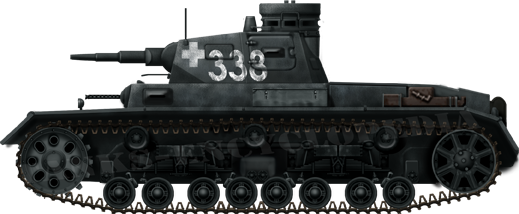
A Panzer III Ausf.C, Poland, September 1939.
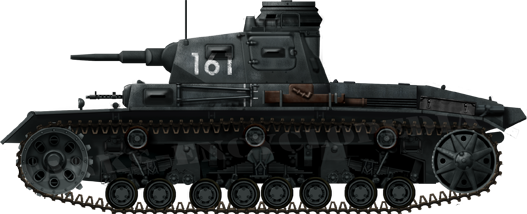
An early Panzer III Ausf.D, XIth Panzerdivision, Poland, September 1939. The D had extra protection and a new, reworked suspension system.
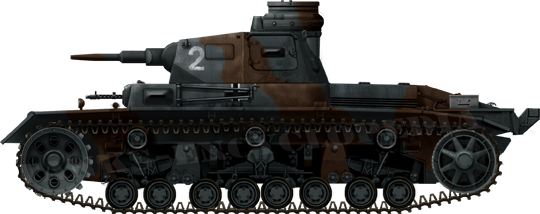
Panzer III Ausf.D, the last and biggest pre-production series. These were the testbeds for the mass-production Ausf.E. This one served in Norway, near Lillehamer in February 1940. The ochre camouflage, applied directly on the usual feldgrau livery, was customary in operations.
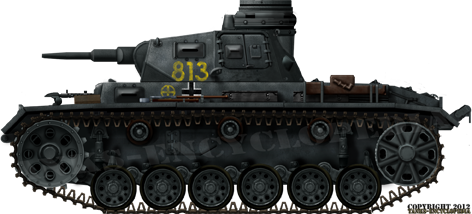
A Panzer III Ausf.E. This was the first actual production series, redesigned for mass production, built by Daimler-Benz, Henschel and MAN from October 1939. Only 96 were manufactured, but its features endured until the last version. It had a shortened hull, brand new independent torsion bar suspension (by Porsche), six roadwheels and three return rollers, increased armor up to 30 mm (1.18 in), side hull escape hatches, new turret two-piece hatches, added vision port and better visor. To cope with the additional weight, a new Maybach V12 HL 120TR with a Maybach Variorex 10 speed gearbox delivered 300 bhp to this new version. Total weight was now far in excess of the 15 tons originally allocated, but general effectiveness was better and many parts were redesigned for mass production.
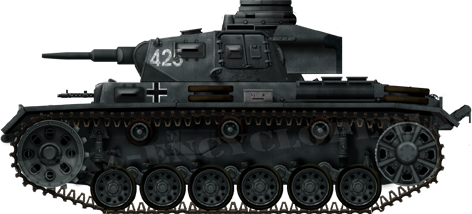
The Ausf.F was a close sibling of the E, and it remained almost unmodified. It was produced by no less than five manufacturers, including Daimler-Benz, Alkett, MAN, Henschel, and FAMO. It had modified air intakes and a slightly improved Maybach 120 TRM engine. External modifications included smoke generator mounted on the rear, controlled from the turret, and sometimes a stowage box at the rear of the turret, which became a trademark of later versions.
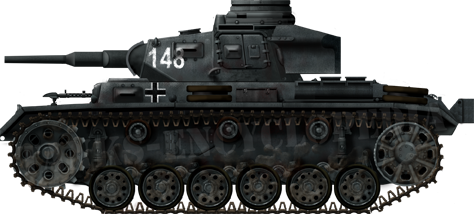
At last, the new 50 mm (1.97 in) KwK 38 L/42, capable of dealing with most French medium and British BEF tanks, was fitted in a rush on a hundred Ausf.F, to be ready for the western campaign. The first ready were shipped to France to see the last days of fighting of June 1940, like this one.
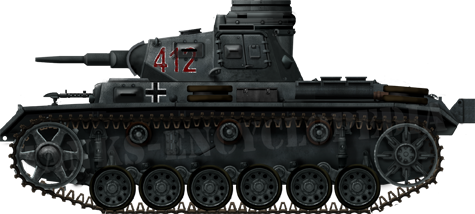
The Ausf.G crystallized many improvements learnt from the campaign in Poland. They were built in 1940-1941. Too late for the western campaign, they became the spearhead of the German offensive in the Balkans (Balkanfeldzug), Yugoslavia and Greece, in April-May 1941. This one is an early production Ausf.G, from the Xth Division, without turret basket and with the original 37 mm (1.46 in) KwK 38 gun. Against the light FT and Hotchkiss H35 tanks of the Yugoslavian army, this was not a handicap.
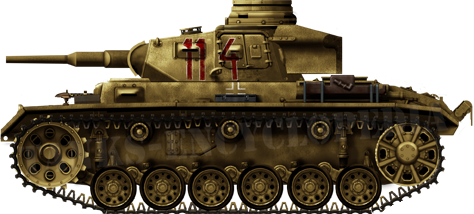
When the first German forces came in Africa in March 1941, they were equipped with the Panzer II and III, most of which were Ausf.Fs and upgunned Ausf.Gs. Since there were few replacements prior to the Tunisian campaign, Rommel could only count on limited provisions of Ausf.Gs and Js during the whole African campaign, from 1941 to early 1943.
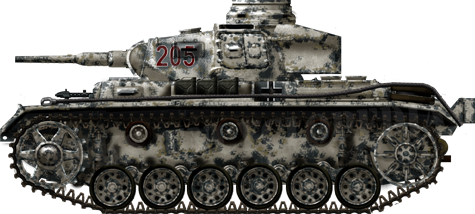
Prior to the Russian campaign, almost all vehicles had been retrofitted with the new, more efficient KwK 38 L/42 50 mm (1.97 in) gun. Here, one of these upgunned Panzer IIIs Ausf.G of the Central Army corps, stuck in front of Moscow in December 1941. Note the transitional, washable white paint. Late production Ausf.Gs received an improved commander cupola and new enlarged tracks, better suited to the Eastern front.
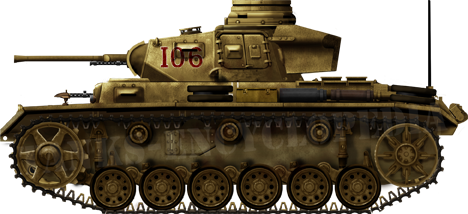
A Befehlspanzer Ausf.G-H, transition model equipped with the new set of drive and idler wheels, new tracks, and some tropicalized features. The Befehlspanzers prior to the Ausf.K were all equipped with dummy guns and powerful radios.
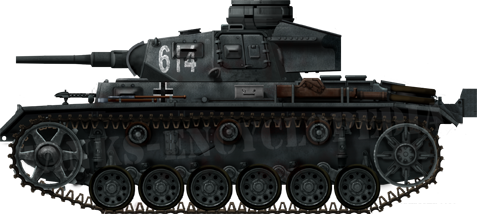
A Panzer III Ausf.H, an evolved model of the G, only produced in 308 units, nearly all fitted with additional armored plates bolted on the frontal glacis and rear. Russian front, Group Army North, operation Barbarossa, September 1941. They also originally mounted the 37 mm (1.46 in) KwK 36 gun. Later, they were equipped with the 50 mm (1.97 in) L/42, and some were even retrofitted in 1942 with the high velocity, long barrel KwK 39 L/60. This gun gave the series the much needed punch against Soviet tanks.
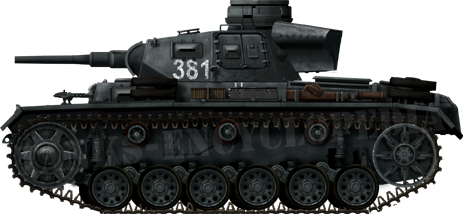
The Ausf.J was a real step forward because of its new, slightly larger and redesigned hull, with increased armor up to 50 mm (1.97 in) at the front, and the J1 variant received the 50 mm (1.97 in) KwK 38 L42 gun right from the start, with a new mantlet. The hull machine gun received a ball mount and the visor was also new. This early Ausf.J (482 built in 1941) fought with the Vth Division in Kuban, Ukraine, March 1942. The short barrel 50 mm (1.97 in) was replaced by the long barrel version. By 1943, only a handful had survived.
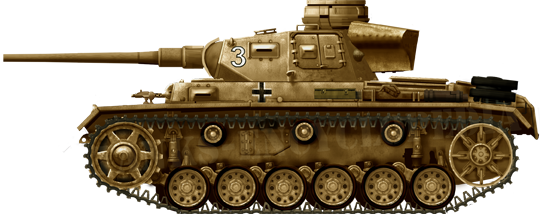
Although nearly all Panzer IIIs were upgraded with the L42 gun, this medium barrel never gave satisfaction against the superior armor of the Russian KV-1 and thick sloped armor of the T-34. The introduction of the new gun emerged from to the will of Hitler after the fall of France, but this weapon was available in short numbers, so the Waffenamt postponed its use nearly one year and a half. The late J came just in time for the depleted German Panzerdivisions, which had already lost most of their combat effectiveness. The gun also used longer ammunition, thus reducing their storage from 90 to 84. Most served until 1944.
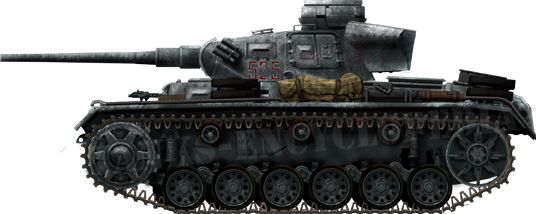
A late Ausf.J in Russia, Group Army South, First Panzerdivision, Stalingrad, December 1942.
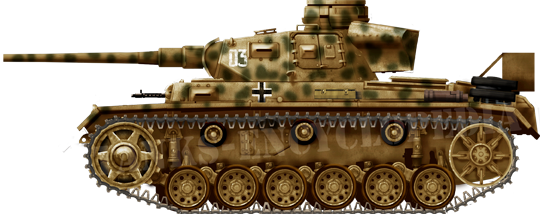
Surviving Panzer IIIs from Tunisia were quickly put in defense of Sicily, like this one of the 15th Panzergrenadier Division, used in the western sector.
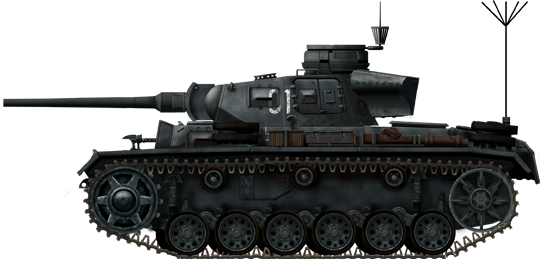
In October 1941, it was decided to use the standard Panzer III Ausf.J to accommodate a new, smaller radio, without giving up their main gun and firepower, but sacrificing one ammunition rack. 300 of these Panzerbefehlswagen Ausf.K mit 5cm KwK L/42 command tanks were converted and gradually introduced on the front in 1943. Since the L60 gun fielded by the Ausf.L and M had a far better muzzle velocity, 50 of these upgunned types were to be chosen for the same task, and equipped with new long, medium and short range radio sets. The custom-built Ausf.K arrived in late 1942/early 1943. Most were given to SS Panzerdivisions fighting on the Eastern front, like this one.
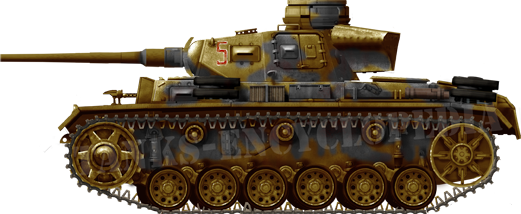
Panzer III Ausf.L TP early production vehicle (1942), a transition model equipped with the Ausf.J turret, the standard long barrel 50 mm (1.97 in) KwK 38 L60, and specialized equipment for desert warfare (hence the name TP, “Tropisch”), essentially additional air filters and new cooling ratio. Facing mostly light Stuarts, Crusaders and half-tracks, the late Panzer IIIs ruled the Tunisian battlefield despite inferior numbers. Their only valuable opponent was the M3 Lee/Grant, which was outclassed by the Ausf.L.
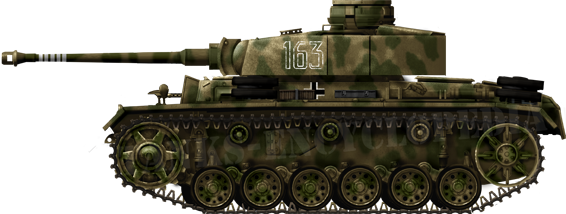
A prototype based on the Ausf L, in a fictional livery, with the muzzle brake still fitted on the KwK 39. The KwK 39 was basically a Pak 38 without a muzzle brake and modified to be fitted in the Panzer III turret. Notice the protective panels around the turret, to deal with the AP rifles of the Russian infantry.
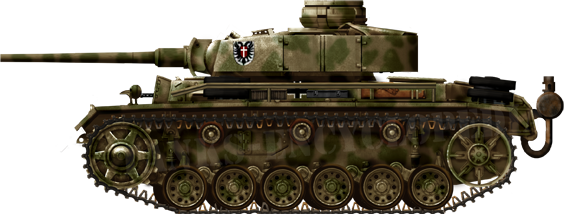
Early production Ausf.M of the 3rd Panzer Regiment, IInd Panzerdivision at Kursk, July 1943. Notice the turret spaced armor. The Ausf.M was an improvement over the previous J, with 20 mm (0.79 in) of extra superstructure front and mantlet armor, and with a fording equipment exhaust which allowed deeper river crossings, already developed on the Tauchpanzer III. The gun, however was the same. They also had three 90 mm (3.54 in) NbK smoke dischargers mounted on both sides of the turret. A total of 1000 were ordered, but only 250 were completed. The others were either converted to Ausf.Ns, StuGs, Flammpanzers, or simply dismantled.
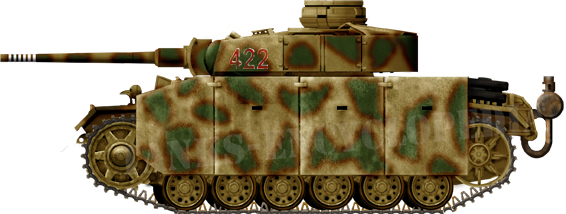
A late built Ausf.M, with turret spaced armor and side skirts (Schürzen). These became common features for all Panzer IIIs and IVs by 1943, as a response to the anti-tank rifles used by the Russians and Allies. They also were fitted with a rotating mount around the commander cupola, for an extra AA MG 34 machine gun.
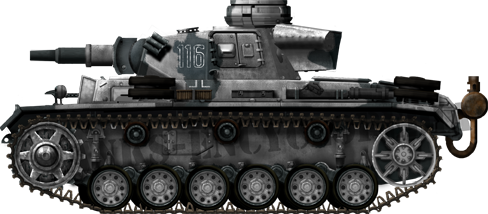
Sturmpanzer III (Ausf.N) early production vehicle.
Previous attempts were made on the Ausf.L to adapt the turret of the Panzer IV and its gun, but they failed. Later, Daimler-Benz succeeded in equipping the Panzer III turret with a new mantlet, accommodating the short barrel 75 mm (2.95 in) already largely produced for the early versions of the Panzer IV. The early version had many differences compared to the late ones.
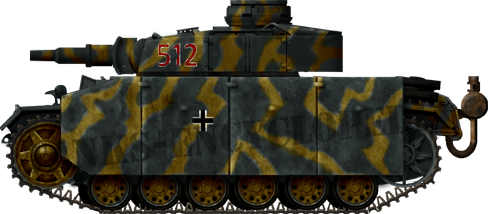
The late Panzer III Ausf.N had many new features, like the reintroduction of the space armor (side skirts or Schürzen), a one piece commander cupola hatch and side turret hatches and received Zimmerit from the factory. The Ausf.N served as close protection vehicles for the Tiger battalions (sPzAbt/sSSPzAbt), and in a close-support role in Panzergrenadier divisions.
Pz.Kpfw.III variants
Besides the famous StuG, or Sturmgeschütz III, family (9500 built) based on the Panzer III chassis, suspensions, tracks and engine, almost a dozen specially modified versions were produced. Adding the 1024 Sturmhaubitze 42 (StuH 42), the Panzer III was by far the most widely used of all Axis chassis.
One of the first derivatives was the Tauchpanzer III, an improvised “submarine version” designed for operation Sea Lion (invasion of Great Britain) in August 1940. Modifications included a complete waterproof hull, new exhaust, schnorchel-like tubes and periscope. The total number of these “dive Panzers”, designed to cross the Channel under 20 feet (6 m) of water, amounted to just a few tested machines. The mass-conversion program never materialized, as the invasion was postponed.
The Panzerbefehlswagen III command tanks were converted from all versions after the Ausf.E (roughly one for twelve), and were characterized by powerful radios and a new redesigned, roomier turret interior. They had a dummy gun until the specialized Ausf.K, and this was often an issue in the heat of battle.
The Artillerie-Panzerbeobachtungswagen III was an advanced artillery observation model of which 262 were produced, appearing on the Russian front in 1943.
The Sturm-Infanteriegeschütz 33B (or sIG-33B) was a 1941-42 conversion of regular Panzer III, done by Alkett, into self-propelled chassis for the massive 150 mm (5.9 in) field gun. They found themselves far more suited for this role than the earlier sIG 33s based on the Panzer I Ausf B. However, only 24 were produced.
The Flammpanzer III Ausf.M(Fl) was an Ausf.M-based flamethrower version, of which 100 were derived and used mostly on the Eastern Front, starting from 1942.
The Berganpanzer III recovery tank was a late (1944) version affected to the Eastern Front, mostly to Tiger units.
Panzer III operational history
Invasion of Poland, September 1939
The Panzer III remains famous in tank history, less for its prowess, partly for its own advanced conception, despite being too lightly armed and protected in its early versions, but above all because it is associated with the first four years of successes of the German army. It remains, to this day, a symbol of the Blitzkrieg. In Poland, the Ausf.A to D pre-series were engaged in combat, but the burden fell mostly to the Ausf.E and F, alongside the numerous and lighter Panzer I and II, and a very few Panzer IVs, all split into six Panzerdivisions, with 2400 tanks in all. Because most serious opposition should have been wiped out by the Luftwaffe, these tanks were supposed to deal only with ill-prepared second-line infantry and convoys. Of course, it was not the case, and if the 37 mm (1.46 in) was sufficient against nearly all Polish tanks, their armor was certainly not impregnable to even basic antitank bullets and weaponry, and these proved deadly. The Czech licence-built 47 mm (1.85 in) gun, the UR anti tank rifles, the local-built Solothurn 20 mm (0.79 in) in fixed positions or on TKS tankettes, or the 7TP main gun, all knocked out Panzer IIIs during the conflict. Even the low velocity Renault FT and R35 37 mm (1.46 in) gun was effective at short range, in ambushes. But, above all, the anti-aircraft Bofors 37 mm (1.46 in), chiefly deployed as AA defense, turned out to be, in the heat of battle, a lethal antitank weapon on its own. In all, the Germans had more than 16,000 casualties, and lost 217 tanks (the official figure), but many more were disabled and later repaired.
Norway: April-June 1940
During the so called “phoney war”, there were two major hotspots, in Scandinavia. To the east, Russia attacked Finland. The Panzer III played no part in it, but some Finnish contacts gave some details to German agents about some of the latest Soviet tanks engaged in operations. The real deal was in Norway, were Operation Weserübung took place. Both Allies and Germany competed to cut-or keep the raw iron supply lines, vital for the German war industry. A detachment of about 30 Panzer III Ausf.C and Ds were sent there, camouflaged with maroon stripes. Most of the Panzers deployed there were smaller Panzer I and IIs. These were sufficient, as there was no real opposition from the Norwegian army, despite some antiquated antitank guns. Denmark, also quickly invaded, was no match for the Werhmacht, and the Panzer III never encountered real opposition. In Norway, the French and British expeditionary forces had almost no tank support, and the Luftwaffe once again paid off. Also, the landscape was totally different from the broad, flat plains of north-eastern Europe, not really adapted to rapid movement, and the tanks were used chiefly as close infantry support, and retired early on.
War on the West: May-June 1940
On May, 9, hell broke loose for the west, after a long, idle waiting, during which both sides built up their forces, with a clear advantage to the Germans. The French, despaired of the state of their air force in particular, rushed rearmament programs and bought quantities of modern fighters and bombers from the USA. However, the French armored forces, with the added weight of the well-trained and well-equipped BEF (British Expeditionary Forces), were more than a match for the Wehrmacht. The first assault was conducted against Luxembourg, almost without opposition. Then, the small Belgian and Dutch armies were quickly overrun. The Belgian armored forces mostly consisted of small, light tanks, derived from licence-built Vickers tankettes. Some French light tanks had been bought, the most potent of which were a small batch of Renault AMC-35s equipped with medium-velocity, AP guns. Eben-Emael, the key of the Belgian defense, fell to glider and paratrooper commandos, allowing German armored forces to rush towards the coast and the French border. They faced a courageous, but weightless opposition. The Netherlands, on the other hand, was ill-equipped. Its armored forces comprised of only 39 armored cars and five tankettes. They had almost no antitank guns and weak aircraft support. Despite flooded lands and some improvised barrages and hopeless infantry opposition, the German advance was swift and brutal, and on the 14th of May, this was all over. Belgium, despite resolute opposition, capitulated on the 28th of May.
The battle of France
The French apparently superior forces made the international press have confidence once again that the Allies will contain the German onslaught. Gamelin’s grand plans were unlikely focused on the northern sector defense, showed many weaknesses, of which we should mention the poor or nonexistent communication network and the last minute neutrality of the Low Countries, which prevented an early, efficient deployment in Belgium. The German generals with traditional strategical views were not especially confident of the countries’ capabilities against the French, but the “Blitzkrieg advocates” led by Guderian, thought otherwise. They were the original brains behind Fall Gelb, Case Yellow, also called the “falx plan”, a surprise attack through the thick Ardennes forest, the weakest point of the French defense. German armored forces were instrumental in it, well served by a good road network and air superiority. Panzer IIIs engaged there were all Ausf.E, F and Gs armed with 37 mm (1.46 in) guns. Only a handful of 75 mm (2.95 in) armed Panzer IVs were available, a few for each Panzerdivision. Facing this, the Allied armored forces had better protected tanks, almost impregnable except at short range. Two of them were impregnable to all available German weapons except the 88 mm (3.46 in). These were the French B1 and the British Matilda. During the six weeks of fighting, the Panzer III prevailed through its own qualities. They benefited from excellent communication and coordination, well served by their three-man turret, flexible tactics, speed, and constant cover by the Luftwaffe. However, the Germans suffered 160,000 casualties and 795 tanks were lost of all types, a significant number which highlighted the weaknesses of the same Panzer III, namely the lack of penetrating power of their main KwK 36, and insufficient protection.
War in Africa (1941-1943)
During almost a year, the Third Reich, now master of all of Europe, prepared for even more ambitious operations. The war industry delivered new batches of the improved Ausf.G and H, and a major upgunning plan was on the move, with the new 50 mm (1.97 in) KwK 38 L42. 1941 was, however, not a quiet year. Since the fall of 1940, the disastrous Italian offensives in Greece and later in Egypt, led to a critical situation for the Axis in Africa. Hitler, waging war against the British Empire, could not afford to see their positions threatened in the Mediterranean theater. In January 1941, an expeditionary force led by the already famous gen. Erwin Rommel landed in Libya, with provisions of Panzer III Ausf.F and Gs, which constituted the backbone of his forces. Against the British tanks, besides the Matildas, they had some success, but proved easy targets for the famous six-pounder. They fought well in the desert, were their speed, combined with the tactical genius of the “Desert Fox”, proved invaluable. But constant losses and few replacements led to a growing mixed-equipped force, comprising many captured Allied models, and the Panzer III might was gradually weakened in these operations. After El Alamein in June 1942, the Afrika Korps was in a dangerous position, but the arrival of new forces under the command of gen. Kesselring in Tunisia in 1943, seemed to bring new hope for the Axis. Alongside came a few Tigers and the new Panzer III Ausf.L and M, better armored and equipped with an effective high velocity KwK 38 L60 gun. These, along with cunning counterattacks, US bad preparation and bad weather ensured most of the Axis forces held on, then evacuated to Sicily, a prelude to a long and bloody defensive war in the so-called “soft underbelly of Europe” (Sir W. Churchill).
In the Russian steppes (1941-1943)
Operation Barbarossa was a major undertaking and echoed Napoleon attempt, after his failure to land in Britain, to turn against Russia. Hitler was aware that the Soviets were a strong enemy, but also that the internal disorders of the regime would cause, in case of a quick offensive, a total collapse from the interior. The other motivation, in Hitler’s personal mythology, was to grab considerable lands for the “master race” (Lebensräum). In July 1941, a considerable effort was made by the Germany war industry, and invasion forces were divided between three large armored corps, North, Center and South. These consisted of many new Panzerdivisions, in fact, made from split former units. These forces mostly counted on Panzer IIIs and Panzer IVs, with many Panzer I and IIs in flanking and scouting units. All Panzer IIIs were now upgunned to the J1 standard, with a KwK 38 L42 50 mm (1.97 in) gun. This gun was sufficient against the tens of thousands of BT-7s and T-26s which constituted the bulk of the Russian armored forces. However, the German crews son discovered that both the KV-1 and and the T-34 were immune to their weaponry, even at short range. Later on, the northern offensive ground to a halt around Leningrad. The central offensive, after weeks of struggle in the mud, froze just miles from Moscow. The southern offensive was kept busy in Crimea. The following year, in 1942, a large Soviet counter-offensive repulsed the Center Army Group, and the southern army was mostly destroyed and captured at Stalingrad. The extremes of the Russian weather brought considerable turmoil to the crews and support troops, showing that the Panzer III was not adapted to very low temperatures or to the deep mud of the Russian bad roads. All hopes to regain control were lost at Kursk in the summer of 1943, were many modernized Ausf.Js (with the L60 long barrel), Ls and Ms, equipped with added protection (Schürzen), faced overwhelming swarms of T-34/76s.
The defensive war (1944-1945)
The last versions of the Panzer III, the Ausf.M and N, had improved protection, better guns and AP ammunition, which were conceived to deal with the latest Russian tanks on the Eastern Front. They were used in successive defensive lines, facing overwhelming forces, until the fall of 1944. The L60 used by the Ausf.L and M proved insufficient, but the idea of adapting directly the Panzer IV turret to the Panzer III chassis failed. However, Daimler-Benz engineers succeed in mounting the 75 mm (2.95 in) low velocity gun on the N version, the very last of a long and famous lineage. Production ended in August 1943. By then, these versions were affected to heavy tank companies, which at full strength contained ten Panzer III Ausf.Ns for nine Tigers. By then, older surviving Ausf.J to M tanks joined the Italian front, together with other veteran models, some having fought on since 1941 in Africa. The long barrel, high muzzle velocity guns, combined with improved AP charges like tungsten rounds, good use of the rugged terrain and camouflage by hardened veterans, pinned down Allied assaults in Italy until the end of 1944.
A few, improved Ausf.J to M fought in limited numbers in Normandy, but their movements were constrained because of Allied air supremacy. However, once again, a good use of the bocage proved that the Panzer III was still a match for most Allied tanks. By the end of 1944 the regular Panzer III were no longer the bulk of the German armored forces. They were spread into composite small defensive units. And as the production had stopped earlier, their numbers decreased even more, and by fall of 1944, they were perhaps 80 still operational on the Eastern Front. By then, new generations of US, British and Soviet tanks had nailed their coffin. This type had reached its limits, its former advanced features were now commonly used, and no further up-gunning was possible. However, the Panzer III will remain iconic in the German military of WWII, along with the Messerschmidt Bf-109 and the versatile 88 mm (3.46 in) gun.
Surviving Panzer IIIs
The last Panzer IIIs fought in the Low Countries (Market Garden), Northern Italy (Gothic line), and in eastern Prussia. Perhaps a handful still operational were spread between desperately weakened companies in March-April 1945, like the Steiner Brigade. Others were kept inactive, in operational reserves, in quiet sectors like Norway or Holland, until the capitulation. The remaining were abandoned, disabled and captured. They ended in many museums throughout the world, like the US Army Ordnance museum, Bovington, Saumur and the Deutsches Panzermuseum, among others. It is still possible today to find some wrecks in remote areas, because of the sheer geographic scale of its deployment, including three continents.
More information and a gallery of surviving Panzer IIIs.
Sources
Panzer Tracks No.3-1, 3-2, 3-3, 3-4 and 3-5 by Thomas L.Jentz and Hilary Louis Doyle
The Panzer III on Wikipedia
The Panzerkampfwagen III on Achtungpanzer
History of the Panzer III video

WW2 Tanks




























WW2 tanks posters

All Tiger tanks liveries.

Panther liveries and variants

WW2 Armour - All tanks











Tanks aces and single tanks series

Find more there

Museums, Movies, Books & Games
The Tanks and Armor in pop culture
Tanks and armored vehicles in general are only really grasped when seen first person: The mass, the scale, it's all there. Explore also the way tanks were covered in the movie industry, in books and in video games.Movies:
Best tanks movie on warhistoryonline.com
On imdb.com
On bestsimilar.com/
miltours.com
liveabout.com/
watchmojo.com
Video Games:
pcgamesn.com
historyhit.com
levvvel.com
vg247.com/best-tank-games
mmobomb.com/
alienwarearena.com



